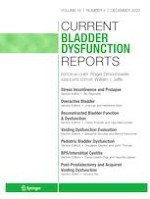Erschienen in:

30.09.2023
Bladder Stones in Pediatric Patients with Bladder Dysfunction: a Review of Pathophysiology and Management
verfasst von:
Christopher J. Staniorski, Esther K. Liu, Rajeev Chaudhry
Erschienen in:
Current Bladder Dysfunction Reports
|
Ausgabe 4/2023
Einloggen, um Zugang zu erhalten
Abstract
Purpose of Review
Bladder stones are a prevalent problem in children with neurogenic bladder that impact quality of life and subject patients to multiple procedures. The physiology of bladder dysfunction as well as medical interventions employed to efficiently empty the bladder and lower bladder pressures contribute to the formation of stones. In this paper, we aim to review the literature concerning bladder stone pathophysiology, prevention, surveillance, and surgical management for pediatric patients suffering from neurogenic bladder.
Recent Findings
Historical data has provided the basis of our understanding of pathophysiology and formation of bladder stones in this population. Various prevention strategies seek to counteract the limitations of catheterization and augmentation to limit the likelihood of stone formation. More recent literature has evaluated strategies to limit the morbidity of recurrent stone procedures with minimally invasive techniques.
Summary
Bladder calculi are a common problem in the pediatric neurogenic population due to alterations in physiology and interventions. Current work in prevention and minimally invasive stone removal techniques will inform our practice for these patients going forward.